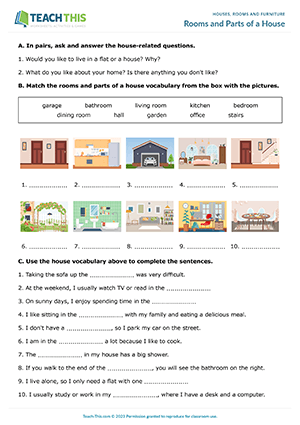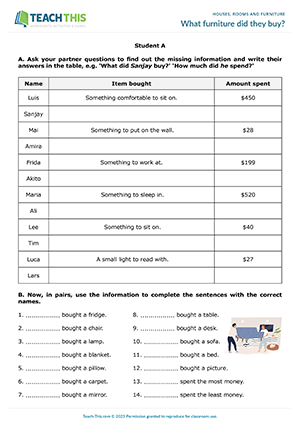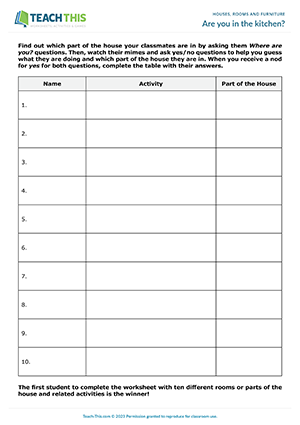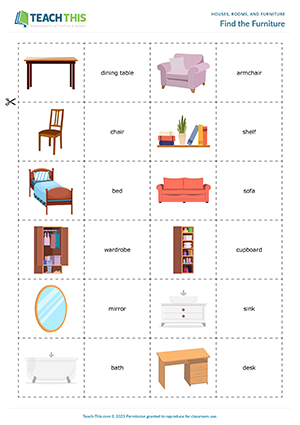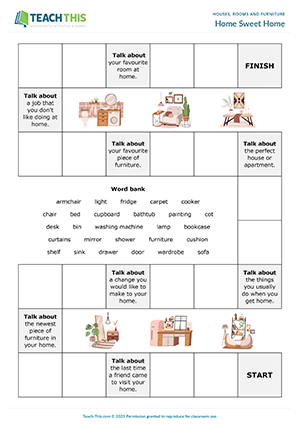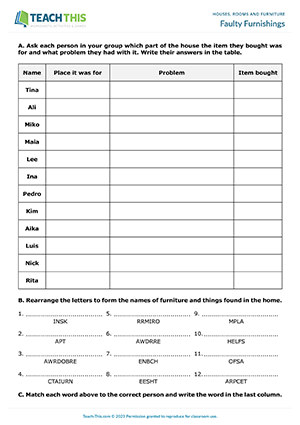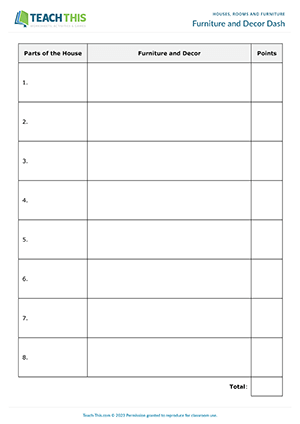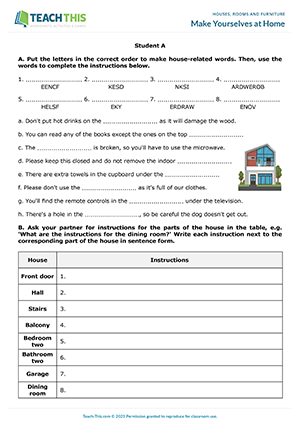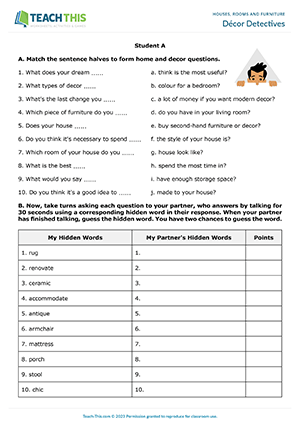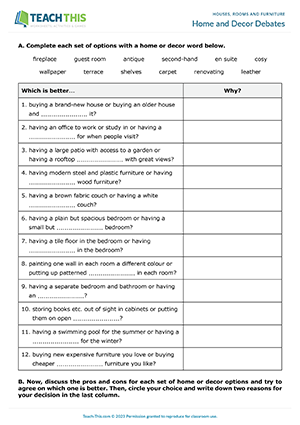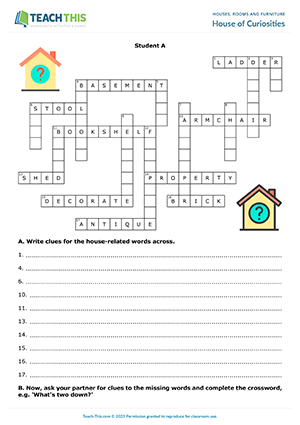In this free house vocabulary worksheet, students learn and practice vocabulary for rooms and parts of a house. First, students discuss two house-related questions in pairs. Students then match rooms and parts of a house vocabulary from a box with pictures. Next, students use the house vocabulary to complete sentences. After that, students think of and write down two examples for each house-related item. Following that, students rank house features from the most important to the least important. Students then tell a partner which features they think are the most important. Finally, students match sentence halves to make home-related questions and then ask and answer the questions with their partner.
Here is a useful furniture vocabulary activity to help students practice words related to furniture and household items. In pairs, students take turns asking their partner questions to find out missing information in a table, e.g. 'What did Sanjay buy?' 'How much did he spend?' Their partner responds, e.g. 'He bought something to eat at. It costs $205'. The student then writes down the answers. Next, working together, students refer to the information and complete sentences about the furniture and household items the people bought. Afterwards, check the correct answers with the class.
This engaging houses and rooms vocabulary game helps students practice making associations between particular activities and different rooms or parts of a house. First, students complete a sentence on a card with an activity that is associated with the room or part of the house shown, e.g. 'I'm making dinner in the kitchen.' Students then play a game where they mime and guess the sentences to find out which room or part of the house the other students are in, and what they are doing there. Students go around asking a classmate a 'Where are you?' question. Their classmate then mimes the sentence on their card. The first student then asks yes/no questions to help them guess the activity and part of the house, e.g. 'Are you eating breakfast?' 'Are you in the dining room?' When the student receives a nod for yes to both questions, they write their partner's name, what they are doing, and where they are in the relevant columns on their worksheet. The first student to complete their worksheet with ten different rooms or parts of the house and related activities is the winner.
In this productive furniture vocabulary game, students match furniture and household item picture cards to word cards and ask and answer Is there...? / Are there...? questions using the vocabulary. To begin, students match furniture and household item picture and word cards together. Next, students play a pelmanism game where they take it in turns to turn over two cards. If the picture and word cards match, the student asks another student an Is there or Are there...? question, linking the piece of furniture or household item to an appropriate room, e.g. 'Is there a wardrobe in your bedroom?' The other student responds Yes, there is or No, there isn't. If the question is correct, the student keeps the two cards and has another turn. If the question is incorrect or the cards don't match, the student turns them back over, keeping them in the same place. The game continues until all the cards have been matched. The student with the most pairs of cards at the end of the game wins.
Here is a fast-paced furniture board game to help students practice vocabulary related to furniture and household equipment. Students take turns picking up a card and reading the sentence to the other students, using the word 'blank' for the word in bold, e.g. 'I went to the living room and sat on the BLANK.' The other students listen to the sentence and race to choose a furniture-related word from the word bank on the game board and say it aloud to complete the sentence, e.g. sofa. The first student to say the correct word shown on the card rolls the dice and moves their counter along the board. If a student lands on a 'Talk about...' square, they talk for 20 seconds about the prompt to remain on the square. If they are unsuccessful, they move back one space. The first student to reach the finish wins the game.
Here is a free furniture vocabulary speaking activity to help students practice words related to furniture and things found in the home. In the activity, each student bought a household item or piece of furniture from a market that has a problem. To start, students take on the role of the person on their card and write their own information in the table. Students then go around their group, asking each group member the intended location of the item they bought and the problem, writing their answers in the table. When the students have finished, they unscramble words related to furniture and things found in the home. Lastly, students refer to the information in the table and write the item that each person bought in the last column. Afterwards, review the correct answers with the class.
In this enjoyable rooms and furniture vocabulary game, students brainstorm furniture and decor words for different parts of a house. Start the game by calling out a random part of the house from the caller's sheet, e.g. bedroom. Each pair then writes that part of the house in the first column. Pairs then have one minute to brainstorm and write down all the furniture and decor words they can think of that go with that part of the house, e.g. bed, wardrobe, etc. When the time limit has been reached, pairs compare their answers. Teams cross off any words from their list that the competing team has on theirs and any words that both teams agree are not appropriate. Teams score one point for each correctly spelt remaining word on their list that the opposing team does not have. The pair with the most points at the end of the game wins.
In this fun house vocabulary speaking activity, students complete instructions for staying in someone's house and then race to exchange information for different parts of the house with a partner. In two groups, students start by unscrambling words related to parts of a house and furniture. Students then use the words to complete instructions for different parts of a house. Next, students pair up with someone from the other group. Explain that the students are going to be staying in a friend's home while they are away and that they have been left instructions for different parts of the house. Each student has the instructions for the parts of the house listed on their partner's worksheet and their task is to race to complete the instructions and match them to the different parts of the house. Students then take turns asking their partner for instructions for the parts of the house on their worksheet and write their partner's responses in the table in sentence form. The first pair to correctly complete the instructions for all the places wins.
In this entertaining house vocabulary game, students answer home and decor questions and try to hide a word in their responses for a partner to guess. In two groups, students begin by matching sentence halves to form home and decor questions. Next, students pair up with someone from the other group and take turns asking each question to their partner, who answers by talking for 30 seconds using a corresponding hidden word somewhere in their response without it being too obvious. When their partner has finished talking, the other student has two chances to guess the hidden word. If the student guesses correctly on the first try, they score two points. If they guess correctly on the second try, they get one point. If the student doesn't guess correctly, their partner reveals the answer and no points are awarded. The student with the most points at the end of the game wins.
In this insightful houses, rooms and furniture speaking activity, students practice home and decor vocabulary and talk about different home and decor options. First, in pairs, students complete each set of options with a home or decor word, e.g. Which is better buying a brand-new house or buying an older house and renovating it? Pairs then discuss the pros and cons for each set of home or decor options and try to agree on which one is better. When the students have decided, they circle their choice and write down two reasons for their decision in the corresponding column. When the students have completed all the options, conduct a class survey to see which home and decor options are the most popular and why.
In this creative house-related vocabulary activity, students complete a crossword by describing and guessing words related to houses, rooms and furniture. In two groups, students invent and write down clues for the words related to houses, rooms and furniture written on their crossword. Next, students pair up with someone from the other group and take turns asking their partner for a clue to one of their missing words. Their partner reads out the clue for that house-related word, and the other student tries to guess what it is. If the student guesses the word successfully, they write it on their crossword. If not, their partner continues to give more clues until the student is able to guess the house-related word. Afterwards, students check their spelling by comparing crosswords.
Latest Free
Resources
- Jigsaw Reading
Reading Exam Preparation (B1)
Date Added: 7th of March
- Writing Jeopardy
Writing Exam Preparation (B1)
Date Added: 6th of March
- Present Perfect Bingo
Present Perfect Yes No Questions (A2)
Date Added: 4th of March
- Count on Me!
Making Offers and Promises (A2)
Date Added: 11th of February
- It’s Carnival Time!
Cultural Celebrations (B1)
Date Added: 29th of January
Latest Member
Resources
- Shops and What They Sell
Shopping (B1)
Date Added: 12th of March
- Who has written this?
Present Perfect Yes No Questions (A2)
Date Added: 11th of March
- Business Greetings and Introductions
Networking (B2)
Date Added: 11th of March
- Have you done this?
Present Perfect Yes No Questions (A2)
Date Added: 7th of March
- True, False or Not Given
Reading Exam Preparation (B2)
Date Added: 7th of March



